When Tesco launched its Finest range 20 years ago this week it ripped up the own-label rulebook. But is there still a place for ‘good, better, best’?
Salmon escalopes with champagne sauce. Quail stuffed with pistachios. A chocolate teardrop good enough to make you “cry with joy” - just a few of the 130-strong Tesco Finest range that first launched into 200 stores in March 1998.
Cloaked in slick black and silver (above right) and developed in partnership with top chefs Anton Edelmann, Nick Nairn and Brian Turner, the top-tier brand couldn’t have been further from the reputation for big volume bargains the retailer had enjoyed until that point.
Eighteen months in the making, the range focused on posh ready meals capable of matching the likes of M&S, luxury beef bourguignon served with creamy potato dauphinoise, followed by rich chocolate tart. All designed to plug a gap for “aspirational and inspirational meals,” the retailer told The Grocer.
The Grocer launches new Own Label Accreditation Scheme
The concept had been cooked up far earlier than it appeared on shelf, remembers former Tesco executive Christine Cross. “It was always envisioned that it would be a three-tier strategy in own label, and it was originally planned that Finest would come out before the Value range.” But when the discounters arrived Value became the priority, the no-frills economy tier, in stripped-back blue and white, arriving in 1993 (three years after Aldi opened its first British store).
So Finest was a long time in the making. “It was all very hush-hush,” remembers Chris Ormrod, MD at The Flavourworks, who was working for Samworth Group-owned Ginsters at the time (a major own label supplier for Tesco. “Then bit by bit details began to emerge.”
“In truth it wasn’t really secret,” adds Cross. It was just a project that didn’t involve existing suppliers but relied on building up a network of entirely new ones. “They took a bit of nurturing as they were a very different group. They often did a lot of smaller production runs and they were very flexible because Finest products changed relatively rapidly, so it required a different type of supplier. That all took a bit of finding, whether a wine supplier, a durum wheat supplier or somebody who would produce very specialised ice creams.”
Twenty years later and the Finest brand has evolved into a proposition of up to 1,400 Finest SKUs spanning every category, from chilled meals to wines, cheeses and single estate coffee worth more than £1bn.
“We thought ‘this is hugely impressive but, gosh, this’ll never sell’. It was so expensive, and so different”
Even more than that though, it was the catalyst for a significant shift in the way retailers - and shoppers - have looked at own label ever since, and its potential to deliver a credible alternative to brands. So what made it such a game-changer? And, two decades later, what is the role of premium private label in UK food and drink?
“It was jaw-dropping when Tesco Finest came out,” remembers Ormrod. “We went to look at it on shelf and thought ‘this is hugely impressive but gosh, this’ll never sell’. It was so expensive, and so different. And it was Tesco. Not to put too fine a point on it, but at the time it was the pile ’em high sell ’em cheap king of the high street.”
The Value range had certainly saddled Tesco with a lacklustre reputation: known by shoppers as the option for cheap tins of baked beans or sad-looking ready meals, the packaging was so stark, street artist Banksy even painted a can of Value soup in an ironic homage to Andy Warhol’s Campbell’s Soup painting.
But at that time, for all the major supermarkets, the tiers of economy and core were all that existed. “As own label suppliers, we were used to making products at a particular price and hitting a certain percentage margin,” adds Ormrod. “Even then the retailers would always come back asking if you could shave another few pence off, take that out or use a bit less butter.”
Conversely, at M&S, developers were demanding decadence, even if it cost an extra 20p. Tesco realised “they had the day-to-day mundane shopping basket but all of the higher-margin purchases were going to Baker Street or Bracknell.” Tellingly, 1998 was the year that M&S, under the leadership of Richard Greenbury, reported a £1.2bn profit, making it the country’s most profitable retailer.
Year-round accreditation by consumers for consumers
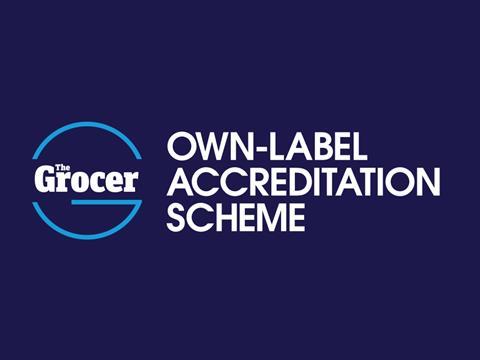
The own-label market is evolving at a rate of knots. Just taking Tesco as an example, in addition to relaunching its Finest range next week, it’s also effectively phased out its Value range, and this week is set to start plugging the 16 tertiary brands that have replaced them, which it’s clubbed together under the banner of ‘Exclusively at Tesco’.
Starting in the fresh produce aisles with the so-called Farms brands in 2016, these tertiary lines have recently extended to ambient goods, deli products, bread, ready meals and frozen goods. On top of that there’s been huge interest in the launch this year of Oumph and Wicked, two new ‘brands’ exclusive to Tesco. It’s all part of a plan - dubbed Project Atlas - to overhaul 10,000 own-label SKUs over a two-year period, it claims.
And if the rate of innovation at Tesco isn’t quite matched at other supermarkets, they’re all frantically busy. Aldi introduced 782 new own-brand food products including specials in 2017. Waitrose developed more than 2,500 products last year, it claims. The Co-op has introduced 500 new own brand product so far in 2018. Morrisons has introduced over 750 new local products in the past year. Sainsbury’s has invested £150m in 930 essential items. Iceland will have completed the reformulation of 130 products and will launch a further 200 new products (containing no palm oil) by the end of this year. Et cetera.
It’s in this context that The Grocer is introducing its Own Label Accreditation Scheme . Sponsored and endorsed by the Private Label Manufacturers Association (PLMA), the scheme will undertake a programme of continuous product testing, to recognise and support successful NPD more quickly. “So accreditation and approval will be as nimble and dynamic as the own-label sector itself,” explains The Grocer editor Adam Leyland.
Accreditation will be powered by consumers. But crucially reviews will be conducted under controlled conditions, with Cambridge Market Research convening nationwide tests, ensuring that cooking instructions are adhered to, and that consumers are pre-screened to match the target profile, and will taste the products ‘blind’ to avoid brand bias.
These controls ensure the accreditation scheme taps the power of the crowd, while ensuring the valuable information consumers provide is evidence-based and objective, says Leyland.
“Having products tested and approved by consumers is powerful. But as we’ve seen with social media, online forums and review sites, while the internet has encouraged people to share their likes, dislikes and opinions in a democratising way, it can result in biased, exaggerated or misleading representation.
“The Grocer Own Label Accreditation Scheme delivers a balanced representation of consumer opinion, with rigorous and objective analysis of the results by market research experts who understand the food and drink industry and how to carry out analysis of the data.
“And the reports we provide as part of the accreditation process will ensure applicants receive valid, valuable and detailed consumer feedback, including star ratings, even if a product is not ultimately accredited.”
The accreditation scheme will also differentiate between value, premium and pioneer lines. In the case of pioneer lines, specialist consumer panels with more adventurous tastes will be picked.
Finally, the scheme will put the focus on achieving a standard, rather than being a winner.
“The new accreditation scheme replaces The Grocer Own Label Awards, and while it keeps some of the best bits - notably the unique consumer panel testing - we’ve listened hard to retailers and suppliers. The result is a scheme that takes us back to our objective when we launched The Grocer Own Label Awards in 2006: recognising, rewarding and supporting sales for the best own-label products,” adds Leyland.
Apply for accreditation at thegrocerownlabel.co.uk.
With Finest all that changed. A clear attempt to grab some of that higher-margin opportunity “the Finest brand represented a huge step change in the market - we had to go back to the start of the product development process and rethink how we made products in scale that could achieve the very highest standard,” says head of Tesco Food Academy Richard Stride, who led the launch (“one of the highlights of my career”).
“In the ready meal area, that meant designing and opening a new factory with one of our supplier partners that enabled us to recreate a restaurant kitchen, with the ability to add hand-finished touches and deliver specially crafted, sophisticated options, but on a larger scale. Nothing like that had ever existed before so it really was taking a step in a new direction for supermarket brands as a whole.”
“They made quite a splash of it,” recalls Richard Harrow, partner at own label consultant IPLC. “It was the first time one of the mainstream retailers had brought out such a defined range in terms of a premium position and launched it with authority, a lot of products coming out in one go. It was impressive.”
For suppliers working on the range, “the premise became this: rather than taking costs out to achieve the best price, what could you add to a product that made it special?” says Ormrod. “Every product had to have a story. It wasn’t just green pesto it was Genovese pesto with a particular basil from a certain part of the world.”
It was a radical move though. Weren’t the team nervous? “No, I don’t think so, because the push came from consumers,” says Cross. “They were saying ‘we want to be able to buy your standard products but something special as well in stores.’ The push was from customers, nobody else.”
Adds Stride: “Offering gourmet food to the masses was a big task, but it was a real gap in the market and we were keen to help our customers make meals even more special.”
Rupert Thomas: fuelling innovation with Waitrose’s development kitchen
If it was a risk, it paid off. The range was soon rolled out nationally, with sales growing rapidly and new SKUs added all the time. Four years later, the range was extended into non-food. It underwent a revamp in 2006, and in a decade was worth £1.2bn for the retailer, after a 37% leap in sales from 2007 to 2008 alone.
Rival retailers watching this success didn’t respond immediately. Not least as it takes at least four months to gather sufficient data and another six - at least - to create a new range, points out Harrow. Finding the right suppliers is another challenge.
However, in the years after the launch, the premium tier began to permeate all major supermarkets. By 2000, Sainsbury’s had launched its Taste the Difference range across 730 lines and the Co-op had experimented with a new premium tier across 70 products too, its full Truly Irresistible range appearing three years later. By 2004, Asda had joined the three-tier approach, adding Extra Special to its own label range, while that same year Morrisons took over Safeway, and inherited The Best (a brand that morphed into M Signature and then back again in 2016). So successful is premium own brand now that UK supermarkets have almost four times more premium SKUs than the average (228) across nine European countries, according to research by IPLC.
“They’ve all looked at the market, seen what Tesco Finest has done and taken the best bits of that to imprint on their own brand,” says Sally Dorling, co-founder of Marketing Foods. In the process, she says, they have created not only high-margin lines but, crucially, a USP to ward promiscuous shoppers away from rivals.
Supermarket buyers: as the role changes, what next?
“They become loyalty builders,” adds Harrow. “Shoppers are very promiscuous but these create something they can only buy in that store.” As a result, “we’re starting to see private label move beyond ‘being there to build margin’ to ‘creating a point of difference’”.
Premium also provides a new, less risky avenue for innovation, adds Sally Hookham, lead innovator at The Food Business. “Premium is a great tool for introducing new trends. Chocolate with 70% cocoa solids, for instance, starts under Finest and then moves to the mainstream. You don’t have the same volume required and it can be used almost like a limited edition, a tool to try out an idea that then goes mainstream.”
But if Tesco Finest had kicked off the premium trend in the late 1990s, its adoption by the discounters - Aldi in particular - was every bit as significant, turning premium almost into a hygiene factor. Launched in 2005, its Specially Selected range now has 300 products across 68 categories and is “on track to deliver sales of £1bn a year,” says Julie Ashfield, its managing director of buying. If it does it will account for around 10% of total sales at the chain, compared with an average of approximately 6% at other supermarkets, according to IPLC.
Master chefs: behind the scenes in the supermarkets’ kitchens
“The range’s popularity and commercial success is testament to our buying team, which continues to invest in all aspects of the category - ranging from packaging redesign to an ambitious line expansion around key times such as Christmas,” adds Ashfield. Crucially though, all products “are benchmarked against the market leader to ensure they are superior, or the same quality, but always sold at our lower price point.”
It’s made the range a regular in the headlines, be it selling two waygu beef burgers for £3.49 or an entire serrano ham leg for only £34.99. Lidl has gone for a similar approach, its Deluxe range offering whole cooked lobsters for £6 or monster 1.1kg cowboy steaks for less than £15. “Own labels are about striking a balance between quality and affordability,” adds Ashfield. “Price is undoubtedly an attraction, and we work hard to ensure shoppers can access luxury products that they may have previously felt they could not afford.
These ranges have “people feeling OK about shopping in Aldi and Lidl, where previously the idea of a ‘discounter’ made them feel they were buying second-rate products,” says Dorling. “For them to have their own premium range and to copy the branding was a masterstroke as it makes people not only feel they’re getting great value for money but also great quality. You can now pull into Lidl in your four-wheel-drive and still be fashionable.”
Tweaking to stay ahead
They’ve also shown UK shoppers that premium quality doesn’t have to mean premium prices, cultivating a shopper quicker to scrutinise the value of the ‘best’ in food and drink. In other words, they’ve forced rivals to up their game, time and time again.
Rarely does a month go by now without one of the major supermarkets making tweaks or additions to premium tiers in an effort to stay one step ahead of the competition. In September Asda unveiled a glittering gingerbread gin under its Extra Special brand. A week later it emerged that the Co-op had turned to members to help it review ‘Irresistible’ products and this month Tesco will attempt to prove its luxe credentials once again with a multi-sensory event curated by Bompas & Parr to mark 20 years of its Finest range.
“If you look at the premium ranges out there now it’s reasonably homogenous and the retailers tend to follow a similar pattern”
Attempting to outperform rivals on premium own label is getting more and difficult though, believes Harrow. “If you look at the premium ranges out there now it’s reasonably homogeneous and the retailers tend to follow a similar pattern. They may put different cues on a product to find a point of difference but that’s getting harder to achieve.”
“Remaining ahead of the pack is, of course, a challenge in today’s ever-changing landscape and with so many brands to choose from, the pressure is really on to provide something unique,” adds Jen McAleer, group own brand director for Tesco Finest. “Our expert team of product developers travel the world in search of the best ingredients, recipes and inspiration to craft our offering. We really go to such lengths to individually develop incredible products.”
So stiff is competition now that even Waitrose succumbed in 2016. For years, the retailer successfully positioned itself as a premium retailer without the need for a separate premium tier among its own brand products. But with the launch of Waitrose 1, featuring the likes of Tanzanian chocolate ice cream with blood orange sorbet, or slow-cooked duck leg laksa, it appeared to concede that was no longer enough.
The premium premise that Tesco Finest launched with 20 years ago - “to stop trying to chase the money down, but chase the ingredients up” - hasn’t changed, believes Ormrod. But the shopper has. “Are they prepared to pay extra for that? Not as much as they were a while back. There’s too much competition.”
The future of ‘good, better, best’
Which raises the question, is there any longer a place for the ‘good, better, best’ structure pioneered by Tesco with such success in 1998? After all, grocery is a very different place to the one Tesco Finest launched into 20 years ago. While once a shiny new premium range was enough to tempt back shoppers from the allure of the discounters and their bargain basement prices, now a solid premium offer is the norm, wherever you pick up your groceries.
“The reality is consumers can buy such good quality in Aldi and Lidl - why do they want to buy an inferior product?”
Unlike 1998 that leaves value - not price - at the crux of creating a competitive edge, with promiscuous consumers happy to shop around for the quality own label they’ve become accustomed to, at the best possible price. For Harrow, that leaves economy ranges on dangerous ground. These value tiers “tend to be used as price fighters against the discounters, but it takes no account of quality. The way the discounters have developed their ranges you have to start questioning whether these entry points are good enough these days. The reality is consumers can buy such good quality in Aldi and Lidl - why do they want to buy an inferior product?”
Ormrod isn’t convinced, however. Savvier shoppers might be less impressed by the stripped-back, starkly packed essentials of the 1990s, but they still want simple basics, signposted as such. “There are a phenomenal amount of people out there where just feeding the family on a week-to-week basis is tough so there’ll always be a place for a 99p sandwich or a low-cost tin of beans, because that’s all some people can afford. If you start to alienate those shoppers from your estate you are giving the discounters an easy ride.”
And that is the last thing Tesco - or any other retailer - wants. Which is why, while celebrating - and updating - its Finest range, it’s given its Value range a major makeover. And if you believe the hype ‘Exclusively by Tesco’ can be just as much of a USP as Finest.
How premium has evolved at 10 supermarkets
Click on an image to expand








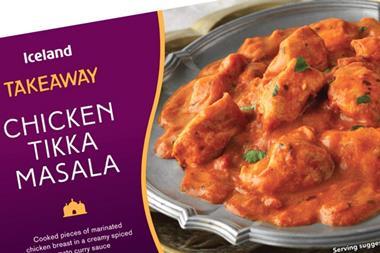
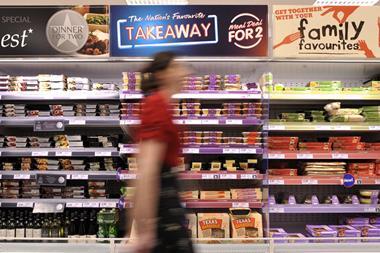

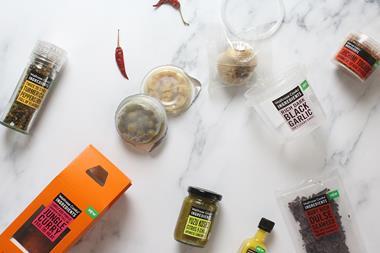
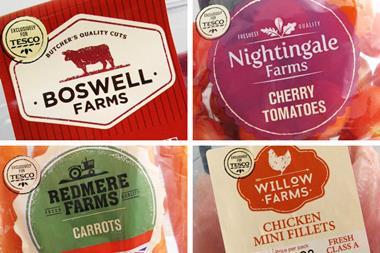






No comments yet